An Analysis of Corporate Social Responsibility Approaches
VerifiedAdded on 2022/08/28
|5
|1129
|25
Report
AI Summary
This report provides an in-depth analysis of Corporate Social Responsibility (CSR), examining the significance of CSR activities for businesses and their stakeholders. The report explores both traditional and non-traditional approaches to CSR, discussing their impact on customer trust, brand image, employee morale, and long-term success. It defines the geographical, demographic, and temporal scopes of a CSR research study and formulates key research questions, including which CSR approach (traditional or non-traditional) is best suited for contemporary businesses. The report also outlines the criteria for fulfilling both traditional and non-traditional CSR activities, offering a comprehensive overview of the subject.
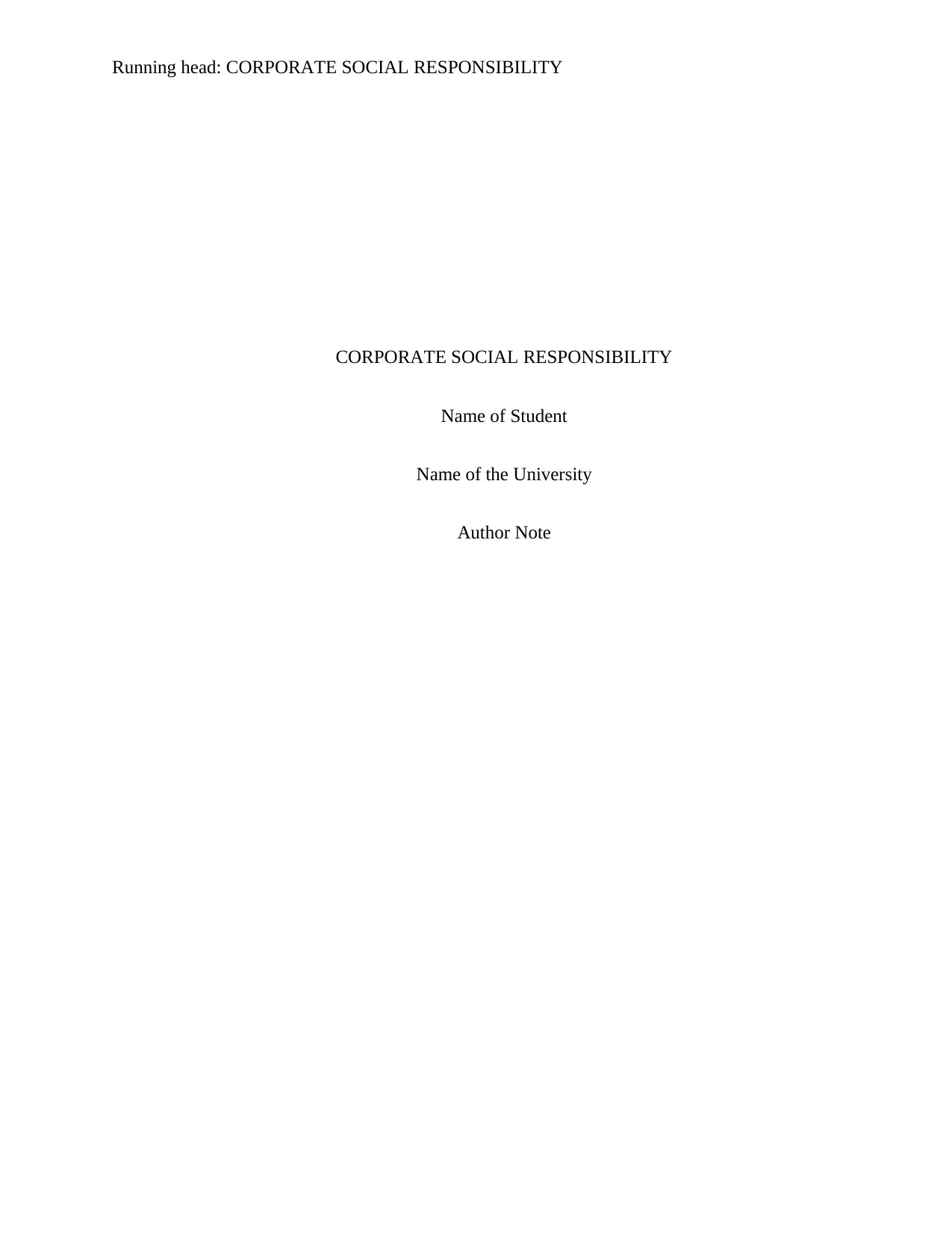
Running head: CORPORATE SOCIAL RESPONSIBILITY
CORPORATE SOCIAL RESPONSIBILITY
Name of Student
Name of the University
Author Note
CORPORATE SOCIAL RESPONSIBILITY
Name of Student
Name of the University
Author Note
Paraphrase This Document
Need a fresh take? Get an instant paraphrase of this document with our AI Paraphraser
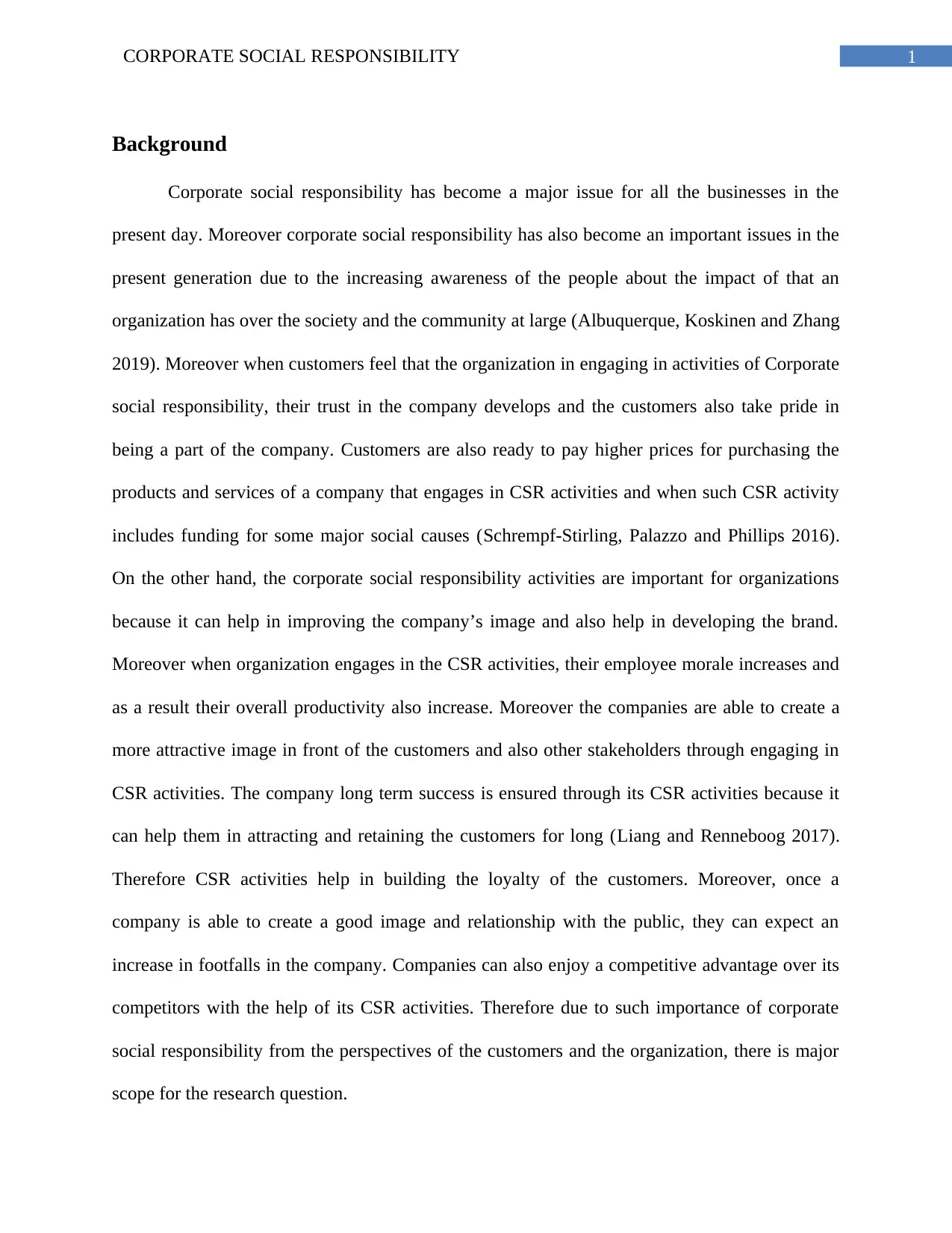
1CORPORATE SOCIAL RESPONSIBILITY
Background
Corporate social responsibility has become a major issue for all the businesses in the
present day. Moreover corporate social responsibility has also become an important issues in the
present generation due to the increasing awareness of the people about the impact of that an
organization has over the society and the community at large (Albuquerque, Koskinen and Zhang
2019). Moreover when customers feel that the organization in engaging in activities of Corporate
social responsibility, their trust in the company develops and the customers also take pride in
being a part of the company. Customers are also ready to pay higher prices for purchasing the
products and services of a company that engages in CSR activities and when such CSR activity
includes funding for some major social causes (Schrempf-Stirling, Palazzo and Phillips 2016).
On the other hand, the corporate social responsibility activities are important for organizations
because it can help in improving the company’s image and also help in developing the brand.
Moreover when organization engages in the CSR activities, their employee morale increases and
as a result their overall productivity also increase. Moreover the companies are able to create a
more attractive image in front of the customers and also other stakeholders through engaging in
CSR activities. The company long term success is ensured through its CSR activities because it
can help them in attracting and retaining the customers for long (Liang and Renneboog 2017).
Therefore CSR activities help in building the loyalty of the customers. Moreover, once a
company is able to create a good image and relationship with the public, they can expect an
increase in footfalls in the company. Companies can also enjoy a competitive advantage over its
competitors with the help of its CSR activities. Therefore due to such importance of corporate
social responsibility from the perspectives of the customers and the organization, there is major
scope for the research question.
Background
Corporate social responsibility has become a major issue for all the businesses in the
present day. Moreover corporate social responsibility has also become an important issues in the
present generation due to the increasing awareness of the people about the impact of that an
organization has over the society and the community at large (Albuquerque, Koskinen and Zhang
2019). Moreover when customers feel that the organization in engaging in activities of Corporate
social responsibility, their trust in the company develops and the customers also take pride in
being a part of the company. Customers are also ready to pay higher prices for purchasing the
products and services of a company that engages in CSR activities and when such CSR activity
includes funding for some major social causes (Schrempf-Stirling, Palazzo and Phillips 2016).
On the other hand, the corporate social responsibility activities are important for organizations
because it can help in improving the company’s image and also help in developing the brand.
Moreover when organization engages in the CSR activities, their employee morale increases and
as a result their overall productivity also increase. Moreover the companies are able to create a
more attractive image in front of the customers and also other stakeholders through engaging in
CSR activities. The company long term success is ensured through its CSR activities because it
can help them in attracting and retaining the customers for long (Liang and Renneboog 2017).
Therefore CSR activities help in building the loyalty of the customers. Moreover, once a
company is able to create a good image and relationship with the public, they can expect an
increase in footfalls in the company. Companies can also enjoy a competitive advantage over its
competitors with the help of its CSR activities. Therefore due to such importance of corporate
social responsibility from the perspectives of the customers and the organization, there is major
scope for the research question.
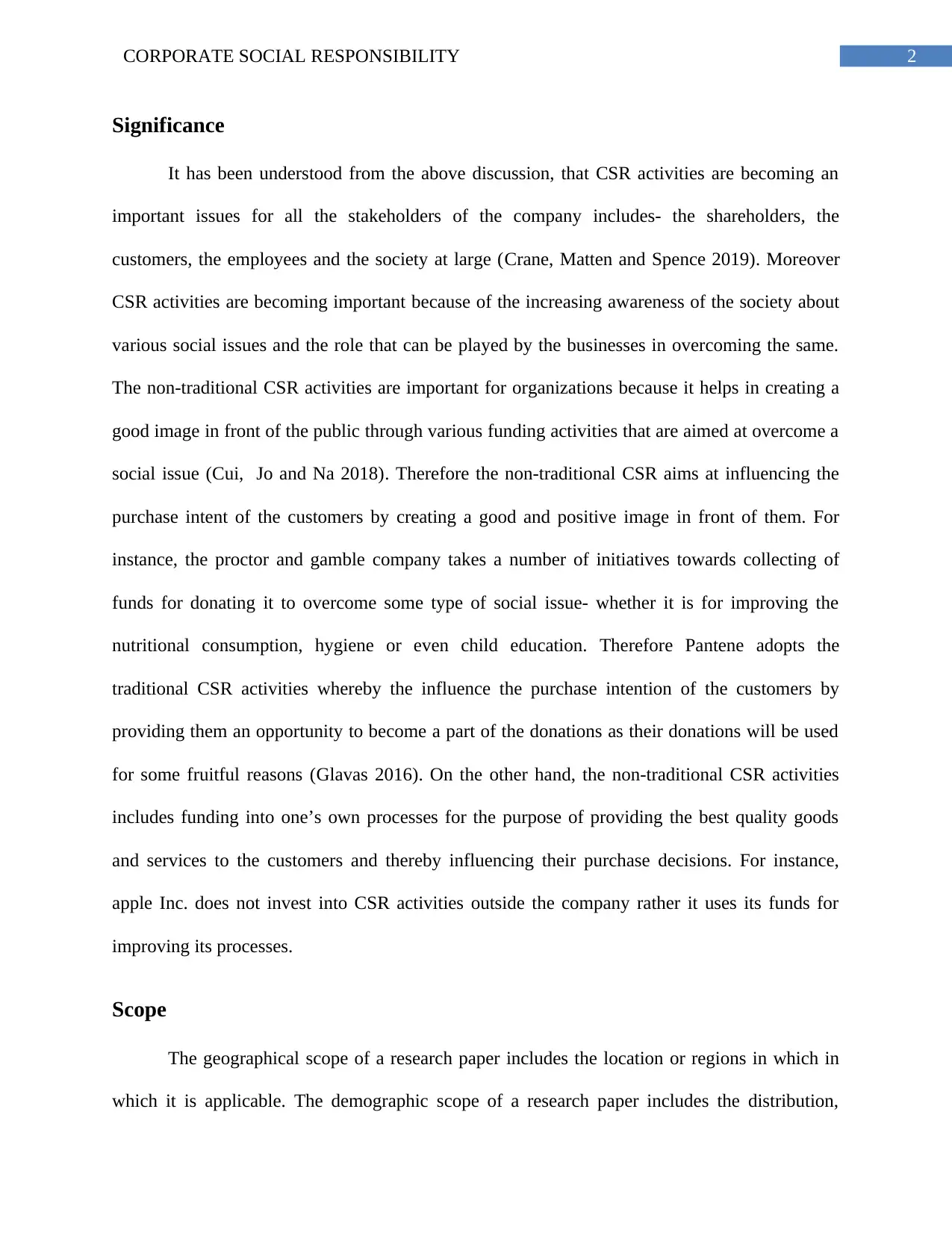
2CORPORATE SOCIAL RESPONSIBILITY
Significance
It has been understood from the above discussion, that CSR activities are becoming an
important issues for all the stakeholders of the company includes- the shareholders, the
customers, the employees and the society at large (Crane, Matten and Spence 2019). Moreover
CSR activities are becoming important because of the increasing awareness of the society about
various social issues and the role that can be played by the businesses in overcoming the same.
The non-traditional CSR activities are important for organizations because it helps in creating a
good image in front of the public through various funding activities that are aimed at overcome a
social issue (Cui, Jo and Na 2018). Therefore the non-traditional CSR aims at influencing the
purchase intent of the customers by creating a good and positive image in front of them. For
instance, the proctor and gamble company takes a number of initiatives towards collecting of
funds for donating it to overcome some type of social issue- whether it is for improving the
nutritional consumption, hygiene or even child education. Therefore Pantene adopts the
traditional CSR activities whereby the influence the purchase intention of the customers by
providing them an opportunity to become a part of the donations as their donations will be used
for some fruitful reasons (Glavas 2016). On the other hand, the non-traditional CSR activities
includes funding into one’s own processes for the purpose of providing the best quality goods
and services to the customers and thereby influencing their purchase decisions. For instance,
apple Inc. does not invest into CSR activities outside the company rather it uses its funds for
improving its processes.
Scope
The geographical scope of a research paper includes the location or regions in which in
which it is applicable. The demographic scope of a research paper includes the distribution,
Significance
It has been understood from the above discussion, that CSR activities are becoming an
important issues for all the stakeholders of the company includes- the shareholders, the
customers, the employees and the society at large (Crane, Matten and Spence 2019). Moreover
CSR activities are becoming important because of the increasing awareness of the society about
various social issues and the role that can be played by the businesses in overcoming the same.
The non-traditional CSR activities are important for organizations because it helps in creating a
good image in front of the public through various funding activities that are aimed at overcome a
social issue (Cui, Jo and Na 2018). Therefore the non-traditional CSR aims at influencing the
purchase intent of the customers by creating a good and positive image in front of them. For
instance, the proctor and gamble company takes a number of initiatives towards collecting of
funds for donating it to overcome some type of social issue- whether it is for improving the
nutritional consumption, hygiene or even child education. Therefore Pantene adopts the
traditional CSR activities whereby the influence the purchase intention of the customers by
providing them an opportunity to become a part of the donations as their donations will be used
for some fruitful reasons (Glavas 2016). On the other hand, the non-traditional CSR activities
includes funding into one’s own processes for the purpose of providing the best quality goods
and services to the customers and thereby influencing their purchase decisions. For instance,
apple Inc. does not invest into CSR activities outside the company rather it uses its funds for
improving its processes.
Scope
The geographical scope of a research paper includes the location or regions in which in
which it is applicable. The demographic scope of a research paper includes the distribution,
⊘ This is a preview!⊘
Do you want full access?
Subscribe today to unlock all pages.

Trusted by 1+ million students worldwide
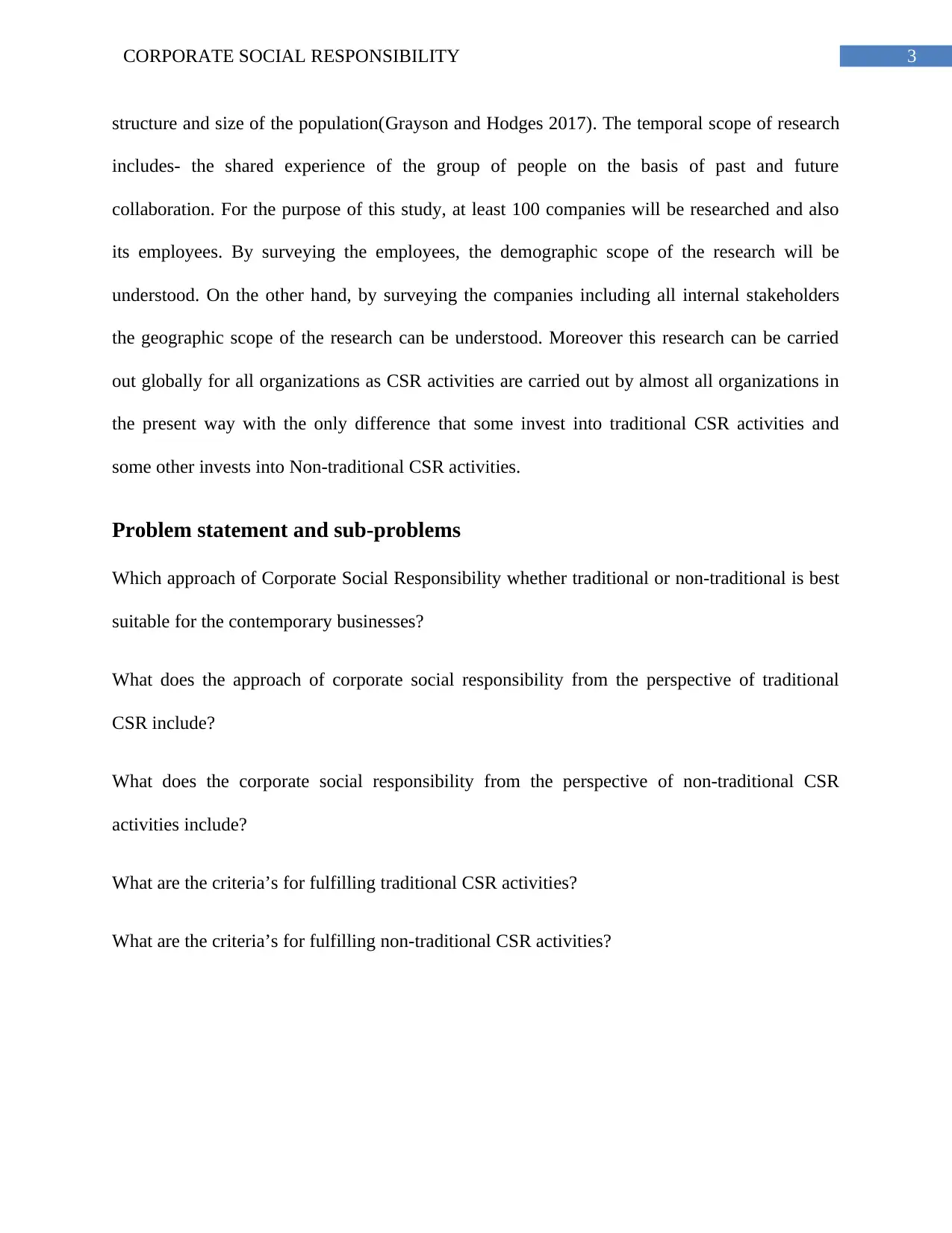
3CORPORATE SOCIAL RESPONSIBILITY
structure and size of the population(Grayson and Hodges 2017). The temporal scope of research
includes- the shared experience of the group of people on the basis of past and future
collaboration. For the purpose of this study, at least 100 companies will be researched and also
its employees. By surveying the employees, the demographic scope of the research will be
understood. On the other hand, by surveying the companies including all internal stakeholders
the geographic scope of the research can be understood. Moreover this research can be carried
out globally for all organizations as CSR activities are carried out by almost all organizations in
the present way with the only difference that some invest into traditional CSR activities and
some other invests into Non-traditional CSR activities.
Problem statement and sub-problems
Which approach of Corporate Social Responsibility whether traditional or non-traditional is best
suitable for the contemporary businesses?
What does the approach of corporate social responsibility from the perspective of traditional
CSR include?
What does the corporate social responsibility from the perspective of non-traditional CSR
activities include?
What are the criteria’s for fulfilling traditional CSR activities?
What are the criteria’s for fulfilling non-traditional CSR activities?
structure and size of the population(Grayson and Hodges 2017). The temporal scope of research
includes- the shared experience of the group of people on the basis of past and future
collaboration. For the purpose of this study, at least 100 companies will be researched and also
its employees. By surveying the employees, the demographic scope of the research will be
understood. On the other hand, by surveying the companies including all internal stakeholders
the geographic scope of the research can be understood. Moreover this research can be carried
out globally for all organizations as CSR activities are carried out by almost all organizations in
the present way with the only difference that some invest into traditional CSR activities and
some other invests into Non-traditional CSR activities.
Problem statement and sub-problems
Which approach of Corporate Social Responsibility whether traditional or non-traditional is best
suitable for the contemporary businesses?
What does the approach of corporate social responsibility from the perspective of traditional
CSR include?
What does the corporate social responsibility from the perspective of non-traditional CSR
activities include?
What are the criteria’s for fulfilling traditional CSR activities?
What are the criteria’s for fulfilling non-traditional CSR activities?
Paraphrase This Document
Need a fresh take? Get an instant paraphrase of this document with our AI Paraphraser
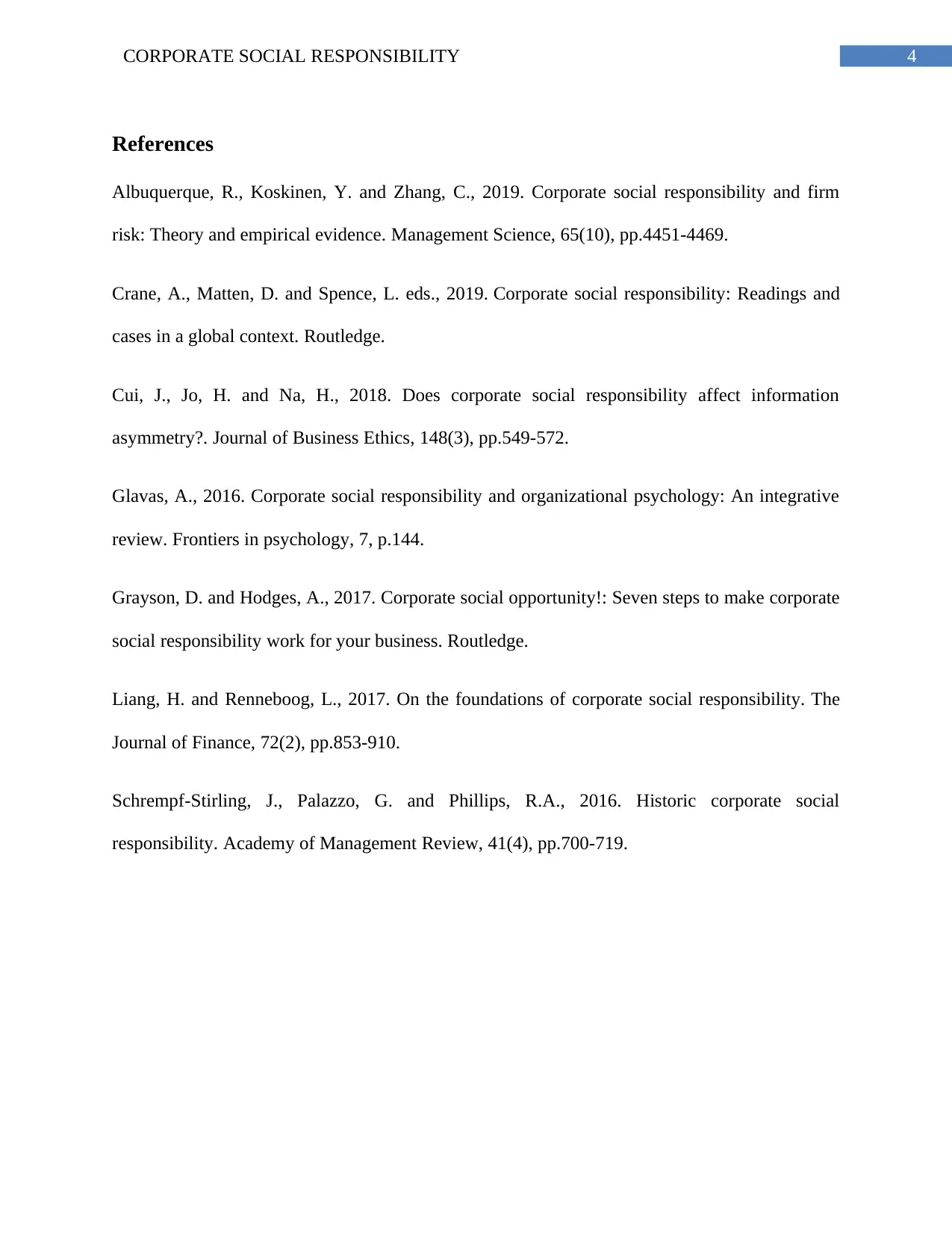
4CORPORATE SOCIAL RESPONSIBILITY
References
Albuquerque, R., Koskinen, Y. and Zhang, C., 2019. Corporate social responsibility and firm
risk: Theory and empirical evidence. Management Science, 65(10), pp.4451-4469.
Crane, A., Matten, D. and Spence, L. eds., 2019. Corporate social responsibility: Readings and
cases in a global context. Routledge.
Cui, J., Jo, H. and Na, H., 2018. Does corporate social responsibility affect information
asymmetry?. Journal of Business Ethics, 148(3), pp.549-572.
Glavas, A., 2016. Corporate social responsibility and organizational psychology: An integrative
review. Frontiers in psychology, 7, p.144.
Grayson, D. and Hodges, A., 2017. Corporate social opportunity!: Seven steps to make corporate
social responsibility work for your business. Routledge.
Liang, H. and Renneboog, L., 2017. On the foundations of corporate social responsibility. The
Journal of Finance, 72(2), pp.853-910.
Schrempf-Stirling, J., Palazzo, G. and Phillips, R.A., 2016. Historic corporate social
responsibility. Academy of Management Review, 41(4), pp.700-719.
References
Albuquerque, R., Koskinen, Y. and Zhang, C., 2019. Corporate social responsibility and firm
risk: Theory and empirical evidence. Management Science, 65(10), pp.4451-4469.
Crane, A., Matten, D. and Spence, L. eds., 2019. Corporate social responsibility: Readings and
cases in a global context. Routledge.
Cui, J., Jo, H. and Na, H., 2018. Does corporate social responsibility affect information
asymmetry?. Journal of Business Ethics, 148(3), pp.549-572.
Glavas, A., 2016. Corporate social responsibility and organizational psychology: An integrative
review. Frontiers in psychology, 7, p.144.
Grayson, D. and Hodges, A., 2017. Corporate social opportunity!: Seven steps to make corporate
social responsibility work for your business. Routledge.
Liang, H. and Renneboog, L., 2017. On the foundations of corporate social responsibility. The
Journal of Finance, 72(2), pp.853-910.
Schrempf-Stirling, J., Palazzo, G. and Phillips, R.A., 2016. Historic corporate social
responsibility. Academy of Management Review, 41(4), pp.700-719.
1 out of 5
Related Documents
Your All-in-One AI-Powered Toolkit for Academic Success.
+13062052269
info@desklib.com
Available 24*7 on WhatsApp / Email
![[object Object]](/_next/static/media/star-bottom.7253800d.svg)
Unlock your academic potential
Copyright © 2020–2025 A2Z Services. All Rights Reserved. Developed and managed by ZUCOL.




